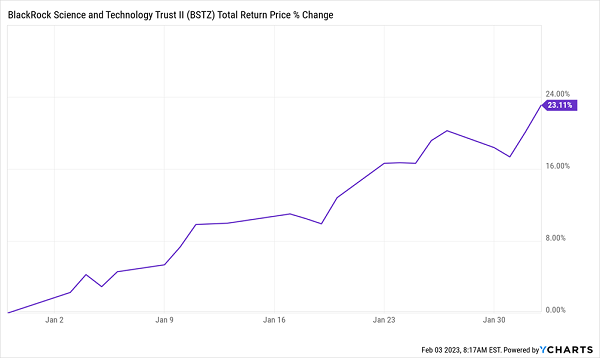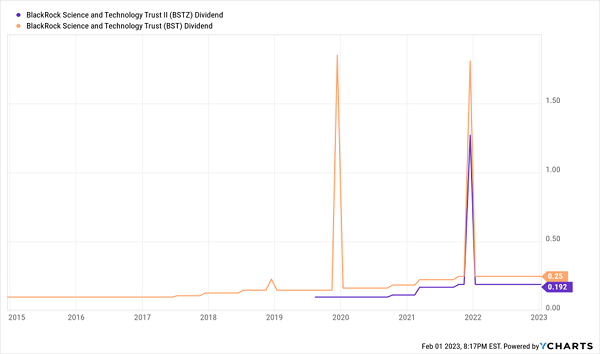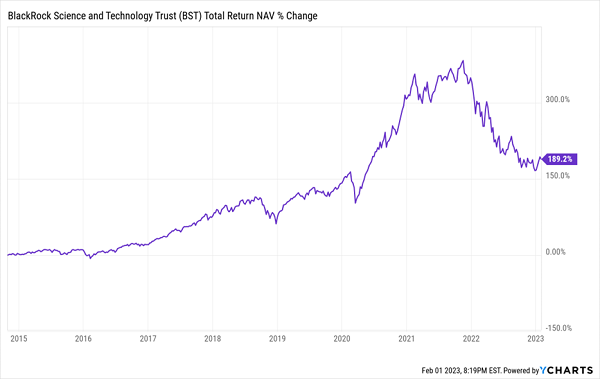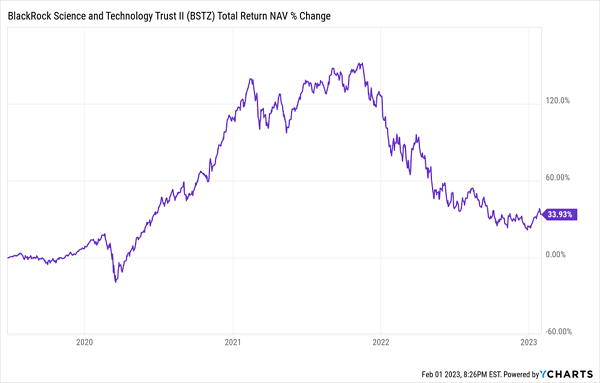Buying This Fund Is Like Buying Apple With a 12.1% Dividend
2023.02.06 06:19
We’ve seen a big bounce (and 12%+ dividends!) in one particular type of closed-end fund (CEF) this year—and all of my buy indicators suggest this profitable play is still in its early stages.
Specifically, I’m talking about tech-focused CEFs—which we’re getting a nice second chance to buy thanks to last week’s earnings whiffs from the likes of Apple (NASDAQ:) and Alphabet (NASDAQ:).
Buying a tech CEF is like buying an ETF that focuses on technology, but with two key differences:
- Big dividends: the CEF we’re going to analyze today yields 12.1%—and it pays dividends monthly, too. You and I know that both of these things are unheard of in the world of “regular” stocks and funds.
- Big discounts: This fund sports a 12.2% discount to net asset value (NAV)—CEF-speak for saying that we’ll pay just 88 cents for every dollar of its assets!
The fund is called the BlackRock (NYSE:) Science & Technology Trust II (BSTZ). We’ll get to the “II” part in a moment. But first, it’s worth stopping to consider what this fund has accomplished just one month into 2023:
Big Gains in Short Order

BSTZ-January-Total-Returns
Then there’s the dividend payout, which amounts to more than $100 per month for every $10,000 invested.
We’ve got more upside potential with BSTZ, too. Because, unlike an ETF, this fund has two ways to deliver price gains: through the appreciation of its portfolio—which is still undervalued, due to last year’s selloff—and its 12% discount to NAV. As that discount narrows (and flips to a premium; likely, in my view), it’ll pull the price higher.
But Is That 12.1% Dividend Sustainable?
It’s always a good idea to question a yield this high, so let’s go ahead and pull apart the elements that support it.
BSTZ is a relatively new fund, having been launched in June 2019, so we don’t have a lot to go on with regard to its history, but it has raised dividends three times since inception (once in 2020 and twice in 2021, plus a nice special dividend that same year). That’s a great start. And there are other signs that we can trust BSTZ’s dividend.
While the fund lacks a long track record, its older sibling, the BlackRock Science & Technology (NYSE:), has been increasing payouts for nearly a decade while also offering the odd special dividend (see the orange line below).
BSTZ’s Older Sibling Paints a Rosy Payout Picture

BST-Dividend-History
That is our first clue that BSTZ’s payout is sustainable: both funds are managed by the same group, and BST’s history of responsible payout increases should indicate that BSTZ’s future payouts will likely go up, not down. And our second clue is even more compelling.
Huge Gains Help Sustain BSTZ’s Dividend

BST-Total-NAV-Returns
Since BST’s portfolio has nearly tripled in less than a decade—even after the big tech selloff of 2022—the fund has built up enough profits to sustain payouts for many years to come.
This isn’t surprising given its portfolio. Despite tech’s struggles last year, Apple (AAPL), Microsoft (NASDAQ:), Mastercard (NYSE:), and Visa (NYSE:) have been tremendous long-term outperformers. They’re also BST’s top positions, and these, in addition to the fund’s investments across the tech world, caused the line in the chart above to go up and to the right for years.
While it doesn’t necessarily follow that BSTZ can do the same, this is one more encouraging sign.
A Quick Guide to Sustainable CEF Dividends
There’s another strategy you can use to see if a CEF’s payouts are likely to stay where they are or go up, or if there’s a risk of a dividend cut.
The key is to look back at the fund’s long-term total NAV return (or the return of its underlying portfolio, including dividends) and compare it to the fund’s payout. This calculation is a good first step in determining whether a CEF can maintain its current payout level.
This Chart Is the Key to BSTZ’s Dividend Future

BSTZ-Total-NAV-Returns
Since inception, and after the worst decline in tech stocks since the Great Recession, BSTZ’s 8.7% average annual total NAV return suggests a sustainable 8.7% yield on NAV.
Don’t sound the alarm bells yet! Because BSTZ’s 12.1% yield is based on its (discounted) market price. And the fund’s 12% discount means that, based on per-share NAV, BSTZ’s yield on NAV (or what management needs to make in the market to hand us its 12.1% yield on market price) is just 10.6%, which is easier to get than 12.1%.
Now let’s assume that 2022’s bear market was an aberration—a very realistic assumption, as tech continues to drive every aspect of our lives and will continue to do so for decades to come. That makes BSTZ’s 12.1% yield extremely stable: before 2022, its annualized return was 38.9%, or more than triple its current yield.
Disclosure: Brett Owens and Michael Foster are contrarian income investors who look for undervalued stocks/funds across the U.S. markets. Click here to learn how to profit from their strategies in the latest report, “7 Great Dividend Growth Stocks for a Secure Retirement.”
Source link








